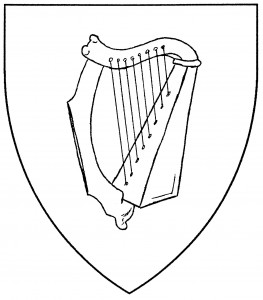A harp is a stringed musical instrument, with many strings stretched across an open triangular frame. As an heraldic charge, it appears c.1450, in the arms of Lantschad or Landschaden [Ingeram 268]. The harp was frequent in arms attributed to King David; it acquired its present association with Ireland under the Tudors.
There are many variants of the harp in heraldry, depending on time and place. The most common form is the “Irish (or Celtic) harp” or “cloyshacke”, as in the illustration: this may always be used if no other form has been specified in the blazon. Some Society blazons specify the shape of the forepillar (e.g., “carved in the shape of a woman’s body”), but this was not done in period; it’s considered an artistic detail worth no heraldic difference. In Society armory, the harp has the forepillar to dexter by default; a “harp proper”, like all wooden charges, is brown.
For related charges, see lyre. See also jew’s-harp.
The Ministry of Arts bears: Purpure, an Irish harp Or.
Milla Meadows bears: Sable, three harps argent.
Theodosius Athanasius bears: Argent, a Byzantine harp azure, a bordure compony azure and Or.
